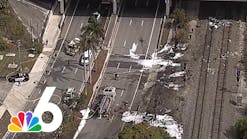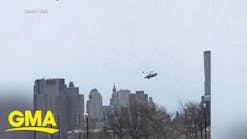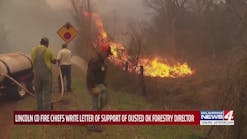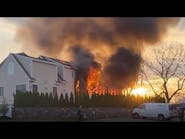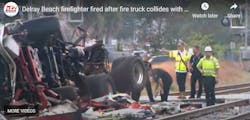This month, I pick up where I left off on the “What Have I Got” phase of operations in my September column. For those of you who will be riding the right-front seat on your fire department unit, these are the things you must understand if you are to perform safely and effectively as the person in that important position. The questions involving these matters can have life-and-death consequences.
In my previous column, I discussed the first four elements of the “What Have I Got” phase of fireground operations: weather, incident type, time issues and height factors. Let us now move on to an extremely critical operational area. Over the past few years, the number of firefighters being injured and killed by construction- and collapse-related causes has grown. There are those who are calling for a complete reevaluation of how we do business, but I am calling for something else.
Risk management and risk avoidance are two elements that must be added to the array of knowledge at every level of our organizations. This is particularly true for those who ride the right-front seat of our first-due units. Our decisions have a direct and instantaneous impact on the level of risk our people will face. Here are a few important thoughts on risk management that you should integrate into your thought processes.
Risk management requires you to:
- Identify risks
- Prioritize risks
- Eliminate the worst risks
- Move on and address the lesser risks
- Work to eliminate all risks from your operation
Good luck with that last one. What I am suggesting is that you look at what you are doing as a fire department, evaluate the risks and hazards, and then work to use the least hazardous ways of getting your job done. Keep in mind that much of what we are doing is inherently dangerous. If we can pick safer ways of doing things, then why not try it that way for a change.
Let us now take a look at four more of the environmental elements of our fireground size-up: construction, occupancies, access and life safety.
Construction
If you and I are going to operate effectively in burning buildings, it is important for us to know how they are built. While the materials can vary greatly, the manner in which they are put together and the elements that hold up a building remain fairly constant.
The International Fire Service Training Association (IFSTA) suggests that “a building (should be) viewed as a system which provides an environment to enhance or support human activity.” To that end, fire officers must learn how fire can attack a building system in the same manner as a physician would diagnose a disease that is attacking the human body. It really is that critical.
Identify and understand the various types of construction in your operational area. Study all of the types that exist, but it is most important to be able to recognize and understand the types of structures you will encounter most often.
Let me make an important distinction here. What do you see most often?
- Old construction (pre-1980)
- New construction (1980-2000 approximately)
- Really new construction (2000-present)
The first three things to consider in any structure are size, type of construction materials used and methods used in building it. These distinctions are crucial. The age and construction of the structure have a direct impact on what you can do and how you can attack (or not attack) a fire.
There is a new development just behind my home. Over the months and years of its construction, I maintained a photo record of just how those buildings were built. Based on what I know about these structures, I might be hesitant to make an interior attack on a well-involved structure. The best part of my methodology is that I can provide a pictorial justification for my decisions. Similar knowledge exists about a number of housing developments in our response district.
My associates and I need to use that knowledge to keep the people in our fire department safe. That is how you must function in those situations where you are riding the right-front seat. Assess what types of construction exist and develop an understanding of how they will react under fire conditions. Acquire a building construction text and use it to develop a deep understanding of all of the construction issues you might encounter.
Occupancies
As the person riding the right-front seat, you can have a great impact on the gathering of information about the occupancies and their attendant hazards in your operation district. But you cannot do this unless you leave the fire station and take a look at what is going on in your community. Knowledge of occupancy hazards does not just pop up and jump into your brain. You must seek out the hazards where they exist.
The following are representative of hazards I have encountered during my more than four decades of service in the world of fire protection:
- High-hazard occupancies – Explosives manufacturing plants, chemical manufacturing plants, paint manufacturing and storage facilities, lumber yards (think indoor lumber companies like Lowe’s and Home Depot)
- Medium-hazard occupancies – Machine shops, pawn shops, hotels with cooking facilities for residents, welding operations
- Low-hazard occupancies – Residential structures, adult day-care facilities, motels, schools, theaters
You are free to agree or disagree with my suggestions as to which occupancies are in which hazard class. That is not of great consequence. What is important is that you learn what occupancies exist within your operational territory and ascertain what hazards they might present to you. In this way, you will be better prepared to handle emergencies when they occur.
Access
If I was you, I would worry about how to gain access to those areas where your services are needed. Go out into your community and learn what is there by making pre-incident planning visits. Being aware of the structural methods and materials used within your district will help you make better decisions when it comes time to deploy your forces. In addition you will be able to discover the ways in which you and the people you are responding with will be able to get into the building (or area) where you need to get to work.
Once you know how to gain access to the structures in your territory, you will be better armed to make decisions on how to do your job. And it is the quality of these decisions that can keep you and your gang safe.
Some of the things you need to consider in this area are:
- Is the building built on terrain that helps or hinders your ability to approach it?
- Is there room for fire apparatus to get close to the structure in the event of a fire or other emergency?
- Is there sufficient external access to enable associated fire and emergency response personnel to be brought near to the building for effective use?
- Is there is sufficient means of access into the building?
- Is there sufficient capability to move in and around the building for firefighting personnel to effect rescue and fight fire?
- Is the building provided with sufficient internal water supply devices (sprinklers and standpipe systems)?
- Is there sufficient internal capacity to allow for smoke venting?
- Is there access to the building system controls?
There is only one way to learn all of these things – visit the facilities in your territory that seem to present the greatest hazard. You cannot phone this one in. Your agency needs to have a pre-incident planning program that allows for the orderly conduct of visits such as I am suggesting. Access is a critical element for every form of emergency response operation.
Life Safety
A number of danger categories affect life safety. It is critical for you to consider all of these when you are the person riding the right front seat. They are:
- The danger to you as an individual
- The danger to those around you from your team
- The dangers to those people from the fire department who are responding in to the same incidents as you
- The danger to the people impacted by the emergency
- The danger to the community at large and anyone who is visiting
What types of dangers do you think I am referring to? Perhaps the primary life safety problem to which firefighters will be exposed in today’s world comes from the many forms of modern construction and construction materials that are designed and built to just barely overcome the force of gravity. There are buildings I have been in which should fall down under their own weight without any exterior damage from fire or excessive wind weight loads.
Here is a list of life-threatening matters you must always consider:
- Heat, smoke and other toxic byproducts
- Electrical hazards
- Injuries and death from the use of power appliances
- Structural collapse
- Chemical exposures
- Freelancing on the emergency scene
Being in the right-front seat comes with some serious responsibilities, not the least of which involves the safety of those who have been entrusted to your care. In addition to the range of hazards you will encounter, you must determine the work quotient of your team. You can seriously injure people by giving them more tasks than they are capable of performing safely. Let me say it in plain language: If you are asking too few people to perform too many tasks, you risk killing or injuring them. One key to achieving success as the person riding in the right-front seat involves providing a proper size-up of the incident you are facing.
However, there is another size-up that is less frequently mentioned in the fire service literature. I am asking you to size up your team so that you have a handle on their strengths and weaknesses. You will soon discover that your team has strengths and weaknesses. Build on their strengths while working to eliminate their weaknesses.
Wise leaders know what their people can do and what they cannot do. Try to operate within the identified limits of your team’s capabilities. Over time, you can broaden their list of “can-do” capabilities, but always try to stay within yourself. This will minimize the risk to your team and maximize their ability to serve your community.
No one ever said that riding the right-front seat is easy. Do not take on the task of leading your fellow firefighters if you are not ready for a lot of blood, sweat and tears.
HARRY R. CARTER, Ph.D., a Firehouse® contributing editor, is a municipal fire protection consultant based in Adelphia, NJ, and a veteran of 47 years in the fire and emergency services. He is chairman of the Board of Commissioners in Howell Township Fire District 2 and retired from the Newark, NJ, Fire Department in 1999 as a battalion commander. Dr. Carter has also been a member of the Adelphia Fire Company since 1971, serving as chief in 1991. He is a life member and past president of the International Society of Fire Service Instructors and a life member of the National Fire Protection Association. Dr. Carter holds six degrees, with his terminal degree being a Ph.D. in organization and management, with a specialization in leadership, from Capella University in Minneapolis, MN, where he is an adjunct faculty member.
RISK MANAGEMENT
- Identify risks
- Prioritize risks
- Eliminate the worst risks
- Move on and address the lesser risks
- Work to eliminate all risks from your operation

Dr. Harry Carter
HARRY R. CARTER, Ph.D., who is a Firehouse contributing editor, is a fire protection consultant based in Adelphia, NJ. He is chairman of the Board of Commissioners in Howell Township Fire District 2 and retired from the Newark, NJ, Fire Department as a battalion commander. Carter has been a member of the Adelphia Fire Company since 1971, serving as chief in 1991. He is a life member and past president of the International Society of Fire Service Instructors and life member of the NFPA. He is the immediate past president of the U.S. branch of the Institution of Fire Engineers (IFE) of Great Britain. Carter holds a Ph.D. in organization and management from Capella University in Minneapolis, MN.
Connect with Harry:
Email: [email protected]

